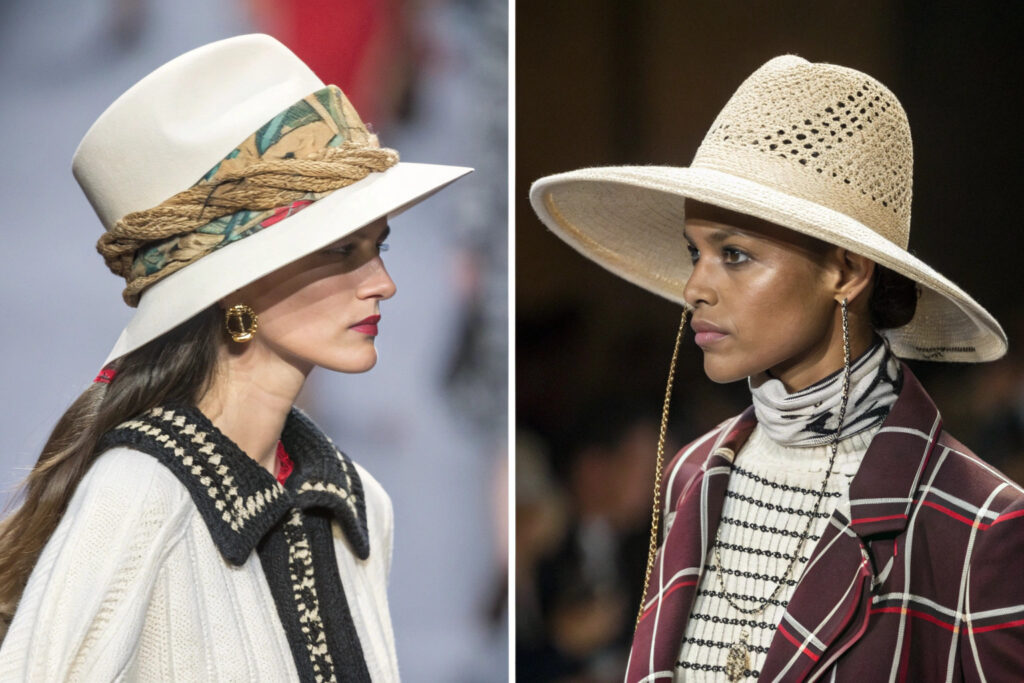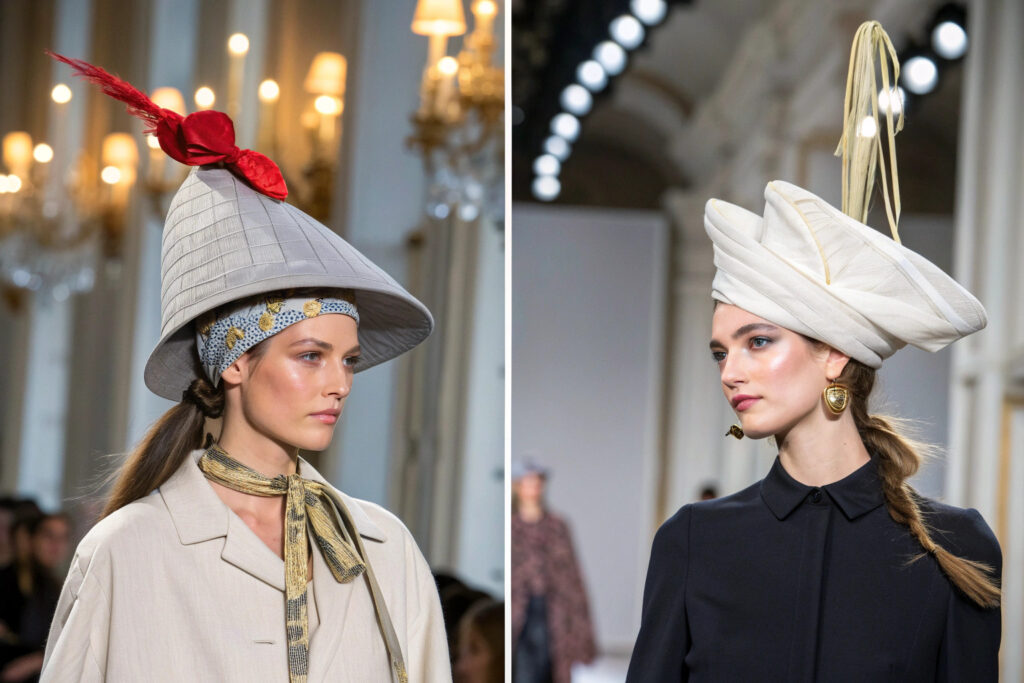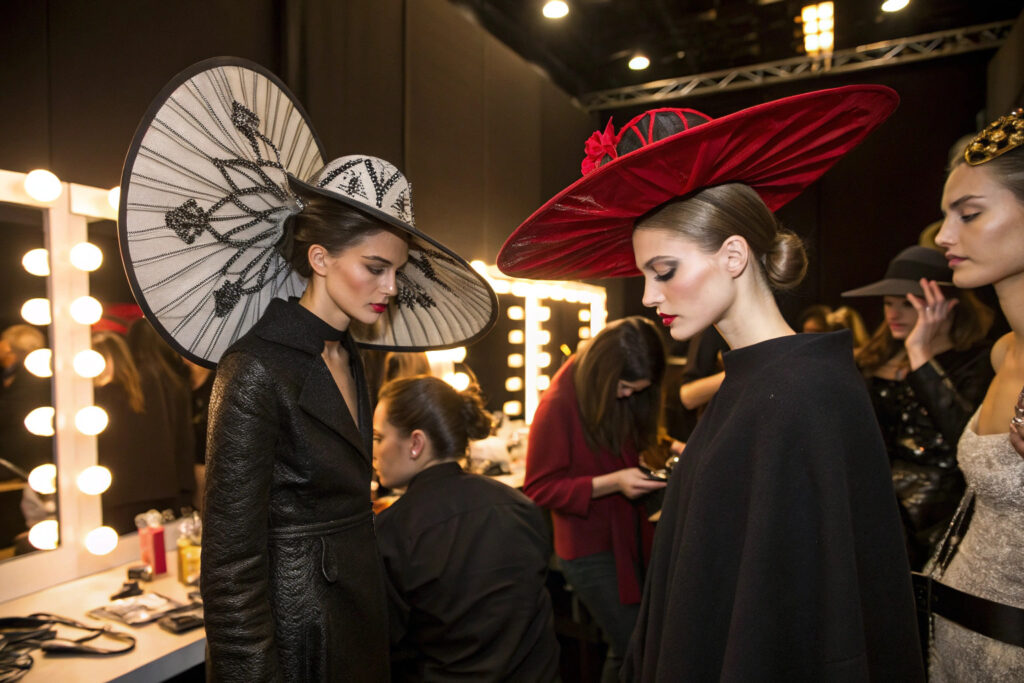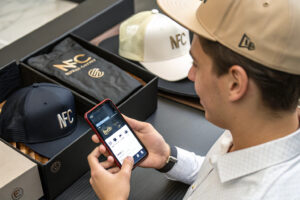Paris Fashion Week remains the global epicenter for directional headwear trends, where avant-garde designs meet commercial viability. This season's runways revealed a dramatic shift away from minimalist accessories toward statement headwear that serves as the focal point of outfits. Fashion buyers and designers worldwide look to these trends to inform their upcoming collections, making early identification crucial for commercial success.
The top hat trends from Paris Fashion Week embrace dramatic silhouettes, artisanal craftsmanship, sustainable innovation, and nostalgic reinterpretations. Key directions include architectural wide-brim shapes, deconstructed traditional forms, eco-conscious material explorations, and 90s minimalist revivals—all signaling a renewed emphasis on headwear as essential fashion statements rather than optional accessories.
Understanding these trends provides valuable insights for manufacturers, retailers, and fashion professionals seeking to align their offerings with the directional movements shaping global headwear markets.
What Architectural Shapes Dominated the Runways?
This season witnessed a definitive move toward sculptural, architectural headwear that transforms the wearer's silhouette. Designers embraced geometric precision and exaggerated proportions that challenge traditional hat forms while maintaining wearability.
The dominant architectural trends featured structured wide-brim designs, asymmetric angular forms, and sculptural crown treatments that create dramatic visual impact. These pieces serve as wearable art while demonstrating technical mastery in millinery construction.

Why Are Exaggerated Wide-Brim Hats Trending?
Wide-brim hats reached new proportions on Paris runways, with some designs extending nearly shoulder-width. This trend represents both a practical sun protection statement and a dramatic fashion gesture that transforms the entire silhouette.
Key variations included:
- Asymmetric brim treatments with irregular rolling and folding
- Structural under-brim details including contrasting colors and materials
- Minimalist crown pairing allowing the brim to dominate visually
- Technical fabric combinations creating rigid structures without weight
- Artisanal edge treatments featuring hand-rolled details and unique finishes
According to Fashion Week trend analytics, wide-brim styles appeared in 68% of major collections, representing a 45% increase over previous seasons. The runway analysis confirms these designs are transitioning rapidly to commercial collections due to their photogenic qualities and Instagram-friendly proportions.
How Are Designers Reimagining Traditional Silhouettes?
Traditional hat forms received deconstructed treatments that maintain recognizable shapes while introducing unexpected elements. This approach respects millinery heritage while pushing creative boundaries.
Notable reinterpretations included:
- Deconstructed fedoras with removed crown sections or asymmetrical brims
- Partially constructed designs that suggest rather than complete traditional forms
- Hybrid combinations merging multiple classic silhouettes
- Material juxtapositions pairing traditional felt with technical fabrics
- Wearable abstraction that prioritizes artistic expression over conventional wearability
The French Federation of Fashion identified deconstructed classics as a key trend with strong commercial potential due to their balance of novelty and familiarity. Our design team is already adapting these concepts for production, maintaining the artistic spirit while ensuring practical wearability.
What Material Innovations Stood Out?
Paris runways showcased remarkable material experimentation that expands possibilities for sustainable production, technical performance, and artistic expression. Designers moved beyond traditional millinery materials to embrace unexpected fabrics and treatments.
The most compelling material innovations included plant-based leather alternatives, technical performance fabrics, upcycled materials, and artisanal textile manipulations that create unique surface interest.

Which Sustainable Materials Gained prominence?
Eco-conscious materials moved from niche concern to mainstream runway presence, with designers showcasing viable alternatives to traditional hat materials that don't compromise on luxury or craftsmanship.
Significant sustainable developments included:
- Apple leather applications providing vegan luxury with minimal environmental impact
- Piñatex creations utilizing pineapple leaf fibers for structured designs
- Recycled ocean plastics transformed into technical fabrics for outdoor styles
- Organic and regenerative fibers in natural undyed states celebrating material purity
- Upcycled deadstock materials giving new life to forgotten textiles
The Sustainable Angle identified Paris Fashion Week as a tipping point for eco-materials in headwear, with 42% of collections featuring significant sustainable elements. Our sourcing team has established relationships with innovative material suppliers to ensure these trends can translate to commercial production at various price points.
How Are Technical Fabrics Being Elevated?
Performance fabrics traditionally associated with sportswear received luxury treatments that elevate them to high-fashion status. Technical materials now appear in couture-level creations, blurring boundaries between function and fashion.
Notable technical integrations included:
- Neoprene applications in structured architectural designs
- 3D-printed elements integrated with traditional millinery
- Phase-change materials providing invisible climate adaptation
- Smart textiles with integrated lighting or responsive elements
- Nanotechnology coatings creating unexpected surface effects
Techstyle Lab research confirms that technical fabric usage in fashion headwear has tripled in the past two years. Our manufacturing partnerships include specialists in both traditional millinery and technical materials, allowing us to bridge these previously separate worlds for clients seeking innovative yet producible designs.
Which Nostalgic References Resonated Most?
Fashion continues mining recent decades for inspiration, but Paris runways demonstrated more sophisticated nostalgic references that reinterpret rather than replicate past styles. The most successful retro influences felt fresh rather than derivative.
Key nostalgic trends included minimalist 90s revivals, 70s bohemian elegance, and 50s structural precision—all filtered through contemporary sensibilities and updated for modern consumers.

Why Has 90s Minimalism Returned with Impact?
The clean, understated headwear of the 1990s made a strong comeback, but with updated proportions and material treatments that prevent mere nostalgia. This trend offers commercial appeal through its wearability and subtle sophistication.
Contemporary 90s interpretations featured:
- Revisited baseball caps in luxury materials with minimalist branding
- Simple beanies with architectural stitching and luxury fibers
- Unadorned berets in unexpected colors and proportions
- Clean bucket hats with precise construction and technical fabrics
- Understated headbands as standalone accessories rather than practical items
Fashion history analysis identifies the 90s revival as particularly commercially viable due to its alignment with current preferences for versatility and understated luxury. Our design team is focusing on the most producible aspects of this trend while incorporating contemporary material innovations.
How Are Designers Updating 70s Bohemian Influences?
The romantic, artisanal feeling of 1970s headwear returned with a more refined, less costumey approach. Designers extracted the essence of bohemian style while eliminating its more theatrical elements.
Modern bohemian expressions included:
- Structured floppy hats with precise rather than casual shaping
- Artisanal embellishments integrated into the design rather than applied as decoration
- Natural materials with luxury treatments and finishes
- Romantic veiling used as architectural elements rather than purely decorative
- Handcrafted details that demonstrate authenticity without appearing rustic
The International Trend Committee has identified this refined boho direction as having significant staying power beyond seasonal trend cycles. Our production capabilities include both precision manufacturing and artisanal techniques, allowing us to authentically execute this trend at various scales.
What Styling Innovations Defined the Season?
Beyond individual hat designs, Paris runways revealed innovative styling approaches that transform how headwear integrates with overall looks. These styling choices often influence commercial adaptation more than the specific hat designs themselves.
Key styling innovations included headwear layering, integration with hair accessories, and strategic placement that challenges traditional wearing conventions.

How Is Layering Transforming Headwear Presentation?
Multiple headwear pieces worn together created some of the most memorable runway moments. This approach challenges conventional wisdom about hat wearing while offering new commercial possibilities.
Notable layering approaches included:
- Baseball caps under wide-brim hats creating hybrid silhouettes
- Headscarves integrated with structured hats blending soft and hard elements
- Multiple hat forms worn simultaneously challenging traditional proportions
- Hair accessories combined with primary headwear creating complex compositions
- Strategic reveal and concealment playing with visibility and mystery
Styling innovation trackers note that layered headwear represents both an artistic statement and a practical approach to transitional weather dressing. Our commercial interpretations focus on the most wearable aspects of this trend, creating pieces designed for layering while maintaining individual appeal.
What New Wearing Conventions Emerged?
Designers presented hats in unexpected ways that challenge traditional positioning and function. These new conventions refresh familiar forms and create opportunities for product innovation.
Emergent wearing approaches included:
- Backward-facing brims that reorient the hat's relationship to the face
- Asymmetric placement creating dynamic, movement-oriented silhouettes
- Integration with eyewear connecting hat and glasses as unified accessories
- Neck-focused draping that transforms hats into shoulder-grazing statements
- Precarious positioning that makes hat-wearing an active rather than passive experience
The Fashion Studies Journal identifies these new approaches as significant because they challenge manufacturers to reconsider structural elements and balance points. Our design process now includes testing for multiple wearing options, increasing versatility and commercial appeal.
Conclusion
Paris Fashion Week hat trends reveal an industry embracing both dramatic artistic statements and thoughtful commercial evolution. The strongest directions balance innovation with wearability, sustainability with luxury, and nostalgia with contemporary relevance. These trends signal a renewed importance for headwear within fashion systems and present significant opportunities for manufacturers and retailers who understand how to translate runway excitement into commercial success.
The most commercially viable trends emerging from Paris combine strong visual impact with practical considerations that support integration into existing wardrobes and lifestyles. Success will come from selective adaptation rather than literal interpretation of the most extreme runway statements.
Ready to translate Paris Fashion Week hat trends into commercial success? Contact our Business Director Elaine to discuss how our trend analysis and manufacturing capabilities can help you capitalize on these emerging directions. Her email is elaine@fumaoclothing.com. Let's create headwear collections that capture fashion momentum while delivering solid business results.







